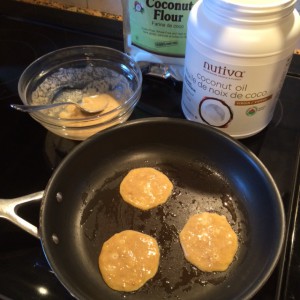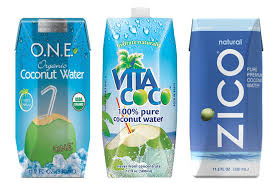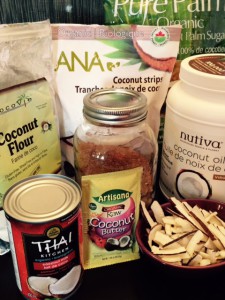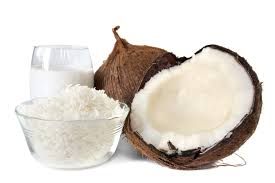Coo Coo for Coconut…and no, it’s not just another fad
So here’s the skinny on coconut…Yep, I said skinny.
Coconut DOES NOT make you fat. Ok?
Read on..
Coconut is one of the healthiest, most beneficial foods I can even think of. Unfortunately, over many years, it developed such a bad reputation based on false information, This created much confusion on whether it belonged in a healthy diet because it contained (and still does) a high amount of saturated fat, which would lead us to heart disease. BUT, that ‘bad’ fat is actually not bad at all. It contains amazing protective health properties and fuels us so efficiently that it’s a crazy wonder (and frustration!) why we’ve been kept in the dark for this long. More about the science behind it all in another upcoming post on FATS. Stay tuned…
Right now let’s dive into why I have a personal love affair with coconut, outlining it’s many body benefits and uses for making food sooooo delicious!
Health Benefits (mostly from coconut oil):
You only maximize on health properties from a food in it’s most wholesome form. So, unprocessed, Organic, cold pressed coconut oil is what you want to look for.
- Contains Medium Chain Triglycerides (MTCs), which are easier to metabolize and use for energy. No time to store them, the body wants to use them right away! This means if you’re trying to lose weight, eating pure coconut won’t cause you to store any access fat.
- These MTCs also create ketones that nourish brain cells and assist in treatments for brain disorders. Recent research supports benefits in treating Alzheimers, epilepsy, Parkinson’s, ALS and autism.
- 50% of coconut’s saturated fat is Lauric acid, which converts to Monolaurin in the body, and takes on anti-bacterial, anti-viral and anti-fungal properties. Hello immune system boost!
- Increases HDL cholesterol (aka the ‘good’ cholesterol) and helps remove any arterial plaque build up ….umm, which the typical cause for a heart attack! So coconut actually protects the heart, doesn’t hurt it.
- Improves thyroid function, stabilizes blood sugar (hunger control!) and has tons of antioxidant properties
There are more, many more benefits, but we need to move on..
Cook with Coconut Oil
- Virgin coconut oil is solid at room temperature, appearing white in colour. When melted (or exposed to higher temperatures) it liquifies and is clear. On warm days your solid container of coconut oil might turn to liquid. It’s melting point is 76°F, but it’s still perfectly safe to use.
- Coconut oil is very heat stable, yes even the virgin stuff. Unlike many oils whose nutrients are destroyed with high heat (i.e. olive oil), coconut oil’s smoke point is high. An unrefined version is available, which is tasteless and odourless. I would only recommend this option if you are doing a lot of deep frying (easy there!) and stir frying. It’s smoke point will be higher, but the virgin stuff is fine for every day cooking, roasting and even broiling.
- For vegan baking coconut oil is the winner! It behaves almost identical to butter, so it works in cakes, cookies, pies, etc. It’s ‘greasiness’ allows it to stretch a longer way than other oils and butter. So, some recipes could even afford a reduction (about 15-20%) in the overall fat content by using coconut oil instead.
- With a temperature sensitive quality, coconut oil is temperamental in some recipes. It DOES NOT hold up well in a salad dressing because it will solidify when refrigerated. Adding cold ingredients to melted coconut oil will harden it instantly, and adding hot ingredients to it when solid will melt it right away. So, for example, don’t handle it too much when making pastry and don’t add cold eggs or milk to a coconut oil batter.
- O.k. coconut milk, sold in a can, isn’t actually ‘squeezed’ out. But it is the soft coconut flesh mixed with the coconut water that pours out when you crack one open. When buying canned coconut milk look for a short list of ingredients: coconut meat/milk, water, may contain some guar gum to maintain thickness. Otherwise there shouldn’t be anything else in there. Buy organic and you’ll have a guarantee. BEWARE: coconut milk spoils quickly once opened. It may last 3-4 days in the fridge, but if you’re not going to use it all by then it should go in the freezer. DO NOT leave coconut milk in an opened can in the fridge. That goes for anything else that comes in a can.
- Food companies are now selling coconut milk as a ready-to-drink beverage. You’ve probably seen it in cartons. It is more processed and diluted than coconut milk from the can, so it’s not the same and doesn’t behave the same in recipes. However if you buy the unsweetened version that’s mixed with almond milk it’s pretty darn delish! My favorite use for it is in a smoothie…or a bowl of cereal.
- Use coconut milk to replace dairy in most recipes: smoothies for sure, ice cream and pudding, cream sauces and soups and baked goods.
Coconut whipped cream? Yeppers! Place a can of coconut milk in fridge overnight. Scoop out the solid ‘cream’ that collects on the top and place in a chilled metal bowl. Take out your electric mixer and beat the cream on high until fluffy. Sweeten if you like. Done.
Coconut sugar and flour
- Cup for cup, you can replace regular brown sugar with coconut palm sugar. It’s not as soft and will have a more ‘dark caramel’ flavour, but it works. Made from the sap extracted out of the coconut palm tree, coconut sugar is lower on the glycemic scale, so it won’t spike your blood sugar. Yahoo!
- Coconut flour is 100% gluten-free. It’s extremely absorbent, so you can’t simply replace other flours with it in recipes. A little goes a very long way.
 I will post more recipes using coconut flour, but in the meantime here’s a quick (and baby friendly!) recipe for Banana Coconut Pancakes using coconut flour:
I will post more recipes using coconut flour, but in the meantime here’s a quick (and baby friendly!) recipe for Banana Coconut Pancakes using coconut flour:
1 small, very ripe banana, mashed (usually organic bananas are smaller)
1/4 cup full-fat coconut milk
2 Tbsp coconut flour
2 organic eggs
good pinch of cinnamon
Whisk ingredients together into a smooth batter. Heat non-stick pan with a little coconut oil to medium and ladel in batter to make 2-3 large pancakes (or 10-12 baby ones), flipping when golden brown on both sides. Eat warm, with a drizzle of real maple syrup, or at room temp like a big super soft cookie 🙂
Snacking on Fresh Coconut
- Crack open a whole coconut, drink the water, and scoop out ¼ cup flesh for a low-glycemic snack. It will satisfy hunger and bridge the gap between meals. You can also snack on unsweetened dried coconut strips, about 1/3 cup, which is likely the easier option. Natural food markets, like Whole Foods, should sell this in a resealable bag. Costco also sells a big bag at a very reasonable price…..my other love affair with Costco in another post…
- Add dried, unsweetened and grated coconut (more commonly found) to baked goods, granola and as a topping for other desserts. You can even toast it yourself for a ‘nuttier’ and sweet flavour: spread a thin layer out on a cookie sheet, bake at 350°F for 3-4 minutes.
Hey Athletes! Hydrate with Nature’s BEST sport drink:
- Pure coconut water is a natural electrolyte drink, very high in potassium (a serving has more than two bananas!) and a perfect thirst quenching beverage for any activity, especially in the summer. With just 60 calories per 11oz serving, it’s close enough to water to offer a little sweet flavour with out any added artificial sweeteners, and freaky bright colours.
- Coconut water (with a tiny pinch of sea salt, just to balance the sodium with potassium for optimal muscle contraction) is my go-to form of hydration in the warmer months. I take it with me on long runs, and drink it after shorter workouts to replenish.
Buyer beware! Coconut juice is NOT the same as coconut water. Read the label. No additional sugar (or anything else) should be included. Some safe brands to look for are O.N.E., Vita Coco, and Zico.
My favorite uses for many of the above Coconut products:
- I keep a big tub of organic virgin coconut oil (Costco has the best deal) in my pantry and use it in my cooking on a daily basis; sauteeing veggies for soups, stews and curries; frying pancakes; frying fish filets (sooo good); making stove-top popcorn (so so so so so so good!); stir-frying Asian dishes; etc. My fave though is tossing melted coconut oil with chunks of root veggies (sweet potato, parsnip, celeriac, carrots and squash) and roasting them in a hot oven with a spice blend.
- Baking with coconut oil to replace butter (sometimes…cause butter is necessary at other times) and especially vegetable oils. For quick homemade recipes like banana bread or muffins, use melted coconut oil. You can cream room temperature coconut oil with sugar for cakes, but recipes that call for liquid vegetable oil, like Carrot cake, work perfectly with melted coconut oil.
- I add coconut milk to smoothies, curry sauce and blended soups (check out my Curried Lentil and Sweet Potato Soup recipe! http://www.kateandthekitchen.com/recipe-items/curried-lentil-and-sweet-potato-soup/
- A switch up my rice pudding recipe with coconut milk from time to time, and add warm spices like cardamom and cinnamon. Sometimes I even fold in toasted shredded coconut or just sprinkle it on top. Toasted coconut also makes it’s way onto my yogurt and berries for breakfast quite often.
- Coconut oil mixed with a little sugar (hey, like coconut sugar!) and cinnamon makes some fancy and tasty cinnamon toast for breakfast! In the summer, slice up some fresh juicy peaches and lay those on your cinnamon toast…hello!
- Once I discovered dried coconut strips (in picture above, also sold at Costco) I became a little crazy on that snack….grabbing by the handful. Can’t help it. So good.
Making baby food is my new hobby these days 🙂 Since the age of 6 months my little guy has eaten coconut oil mixed into his veggie purees and coconut milk blended with stewed fruits for a snack. He loves it! And why wouldn’t he?
Here’s his favorite recipe for Butternut Squash and Coconut Puree (which can be an adult friendly side dish as well):
1 small-medium butternut squash
1 tsp coconut oil
1.) Preheat oven to 400°F. Cut off stem top and bottom of squash, then split vertically down the middle. Line a baking sheet with parchment paper and place squash half flat side (where seeds are) down. Bake in oven for 45 minutes, or until flesh is very soft and brown spots are forming on the skin.
2.) Flip the two halves over and let cool for 10 minutes. Scoop out seeds and discard. Scoop out flesh into a food processor, or high powered blender, and add coconut oil. Puree on high until smooth, scraping down sides if necessary.
3.) Baby food is done! For the adults season with 1/4 tsp salt and pepper, or even less. The coconut oil mixed with squash is an amazing combination and flavourful with out much seasoning. Taste, and then adjust.
Makes about 2 cups. Freeze some for babe and keep the rest in fridge for 3-4 days.
Any additional coconut questions? You know where to find me!
I’m hungry…where’s that bag of coconut strips?..

Hi, I'm Katie!
I am a nutritionist, chef, mom to two little ones, and a lover of food!
I hope you enjoy my recipes and food blog. Feel free to reach out if you have any questions.


